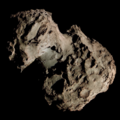 Comet Tempel 2 photographed by H. M. Jeffers from the Lick Observatory in 1946 [1] | |
| Discovery | |
|---|---|
| Discovered by | Wilhelm Tempel |
| Discovery date | 4 July 1873 |
| Designations | |
| P/1873 N1, P/1878 O1 | |
| |
| Orbital characteristics [2] [3] | |
| Epoch | 5 May 2025 (JD 2460800.5) |
| Observation arc | 130.78 years |
| Number of observations | 5,700 |
| Aphelion | 4.710 AU |
| Perihelion | 1.417 AU |
| Semi-major axis | 3.064 AU |
| Eccentricity | 0.53738 |
| Orbital period | 5.362 years |
| Inclination | 12.027° |
| 117.80° | |
| Argument of periapsis | 195.50° |
| Mean anomaly | 276.53° |
| Last perihelion | 24 March 2021 |
| Next perihelion | 2 August 2026 [4] [5] |
| TJupiter | 2.965 |
| Earth MOID | 0.410 AU |
| Jupiter MOID | 0.622 AU |
| Physical characteristics | |
Mean diameter | 10.6 km (6.6 mi) [6] |
| 8.948±0.001 hours [7] | |
| 0.022 [8] | |
| Comet total magnitude (M1) | 14.3 |
10P/Tempel, also known as Tempel 2, is a periodic Jupiter-family comet with a 5-year orbital period. It was discovered on 4 July 1873 by Wilhelm Tempel. [9] At the perihelion passage on 2 August 2026 the solar elongation is calculated at 164 degrees, with apparent magnitude approximately 8, [4] with closest approach to Earth on 3 August 2026 at a distance of 0.414 AU (61.9 million km). [2]
Contents
| Date & time of closest approach | Earth distance (AU) | Sun distance (AU) | Velocity wrt Earth (km/s) | Velocity wrt Sun (km/s) | Uncertainty region (3-sigma) | Reference |
|---|---|---|---|---|---|---|
| 2026-Aug-03 20:56 | 0.414 AU (61.9 million km; 38.5 million mi) | 1.42 AU (212 million km; 132 million mi) | 6.5 | 31.0 | ± 200 km | Horizons |





